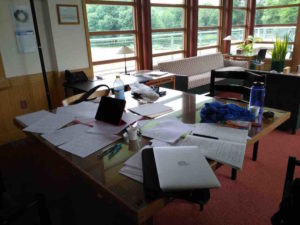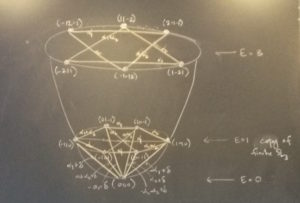A short post reflecting on what I actually did for two weeks at the Institute for Advanced Study this July.
Well, I went to the IAS to work with my collaborator Elizabeth Milićević, a professor at Haverford College. We’d started a project last May (2016) at the Max Planck Institute for Mathematics in Bonn, and we had written an application to the Summer Collaborators program to get some dedicated time to work on the project. Why? We both have many non-research duties at our academic jobs; teaching and curriculum development take time to do well. I also had a baby in May, which apparently takes time whether you do it well or poorly 🙂 Dedicated time to work produces greater results than fragmented time, if you’re prepared to use it — and we were.
We kept a very civilized schedule for our two weeks: meet at 9 on weekdays and 11 on weekends, work until at least 5 but not later than 7, take a break for lunch before the physics workshop arrived in the lunchroom (who wants to stand in line behind 120 postdocs? not me!) and take a break at tea-time (3 pm at IAS). There was also usually a midmorning break and a 5 pm break if we worked late, because the aforementioned baby is still relying on me for breakfast, second breakfast, first through third lunches, etc. My husband came along as the primary care provider for our kid, and he’d often take a couple bottles with him and gain some freedom to go explore or do his own work, but as breastfeeding moms know, production doesn’t stop just ’cause baby’s gone exploring. On the plus side you can carry out computations while pumping. We never worked more than 6.5 days per week, and in fact my family visited several art museums while visiting IAS. Lots of geometrical art: Man Ray, Kandinsky, Sophie Taeuber-Arp, Mondrian, Maria Helena Vieira da Silva.
Liz and I started our mathematical mornings with some caffeination and discussion of any examples or reading we’d done the night before. Although we’d usually have a direction already planned for the day, now and then that initial discussion would cause a slight turn. From the warm-up discussion we’d proceed to discussing a new idea and picking examples with which to test it, working through said examples, or working through someone else’s claims related to our desired results. That really is enough to take up eight hours of solid work. Before going “home” for the night we’d usually assess our results and decide what to do the next day. Since we were only together for two weeks, we didn’t pursue all angles to their full extent — we followed them up to a point where either we were sure they’d work and details could be worked out later or where we were stuck enough that it seemed better to switch to some lower-hanging fruit.
Now we have two approaches to our problem that need to be synthesized but they’re both a little different than what already exists and very geometric, very beautiful. (Of course I’m biased — most moms think their kid is cute, right? and most mathematicians think their theorems are beautiful!) There are still those details to be filled in and some areas to finish planning, but it’s as if the outlines of the portrait have been painted and now we have to fill in the details of faces and fabric and also finish the background.

